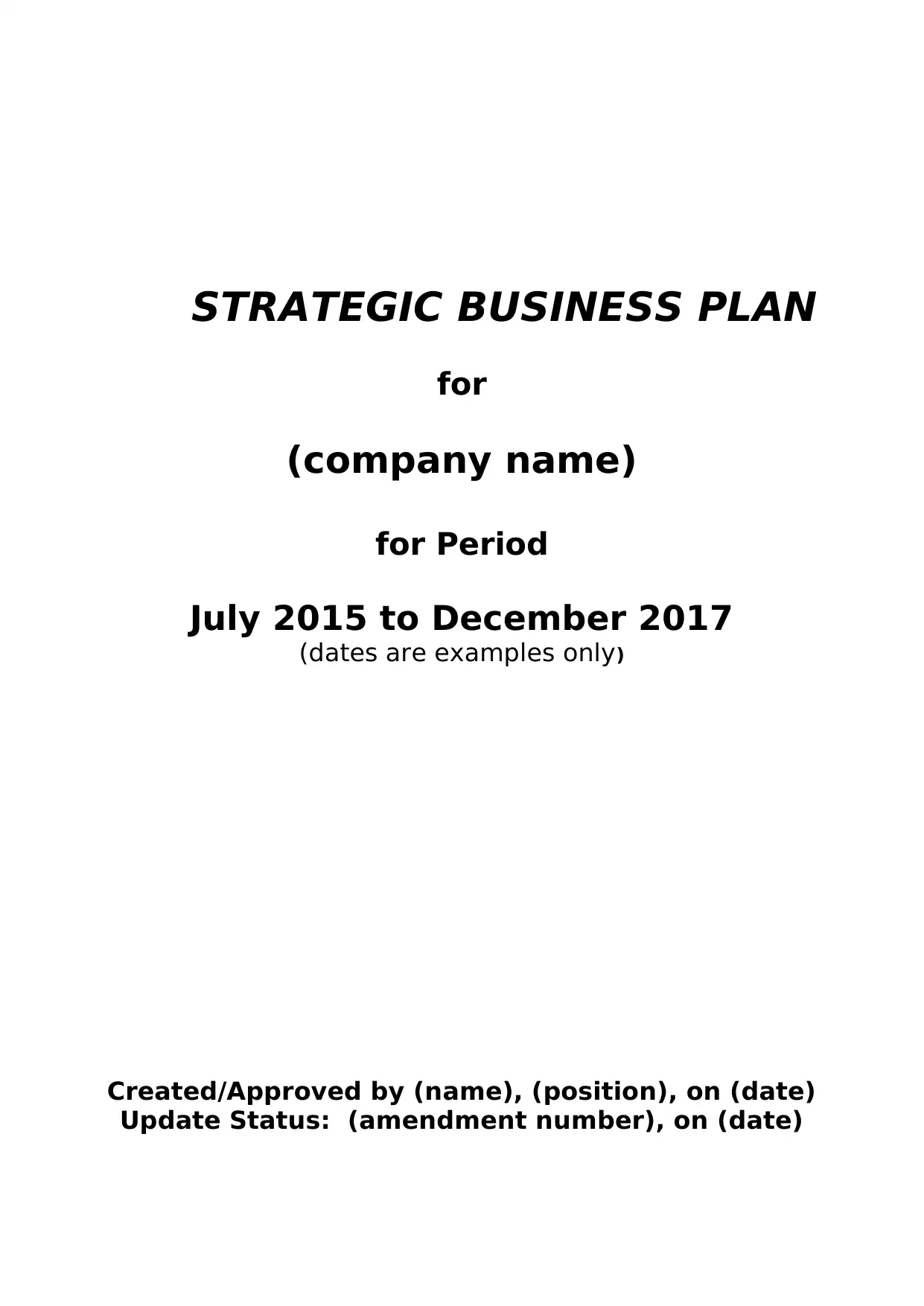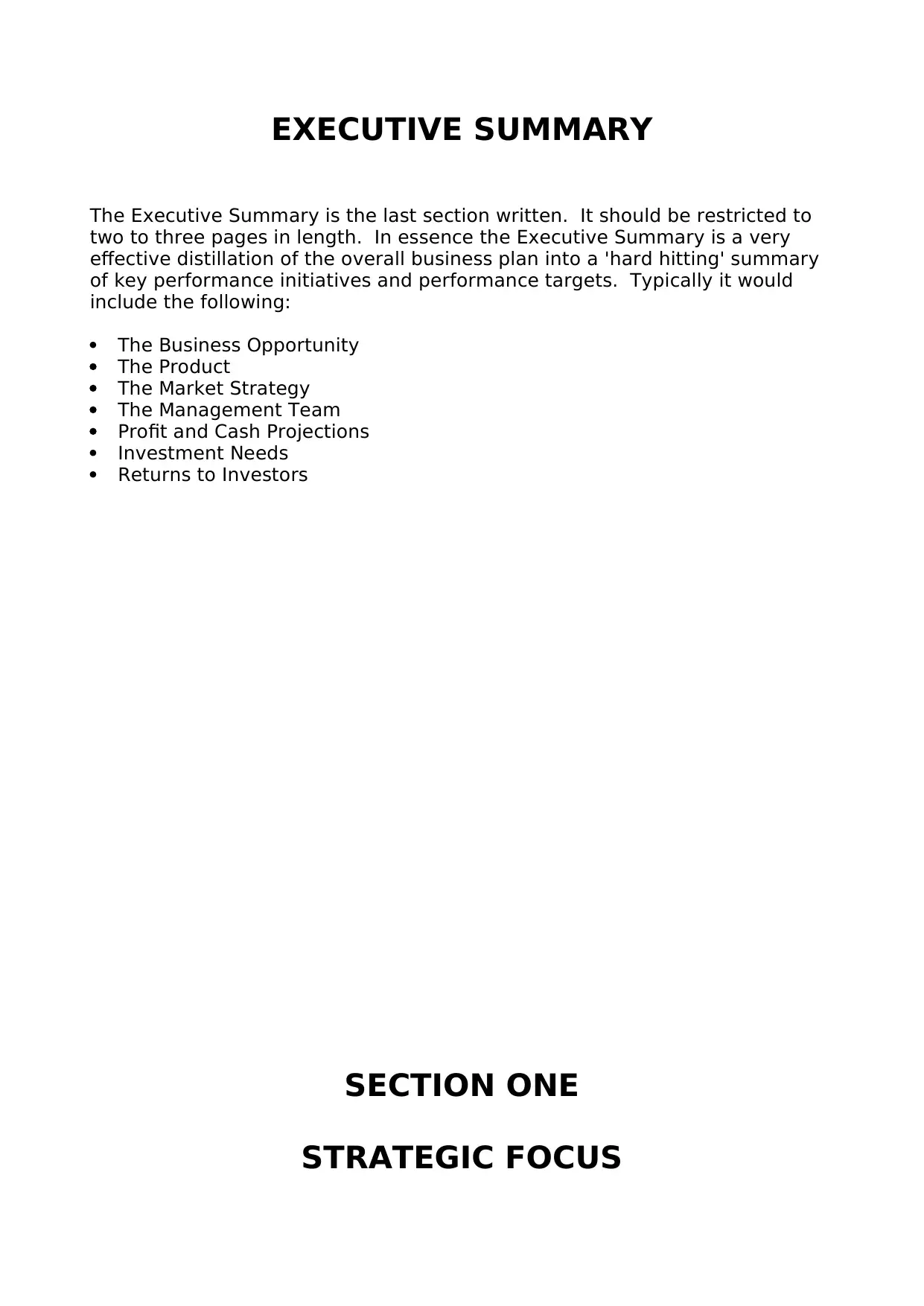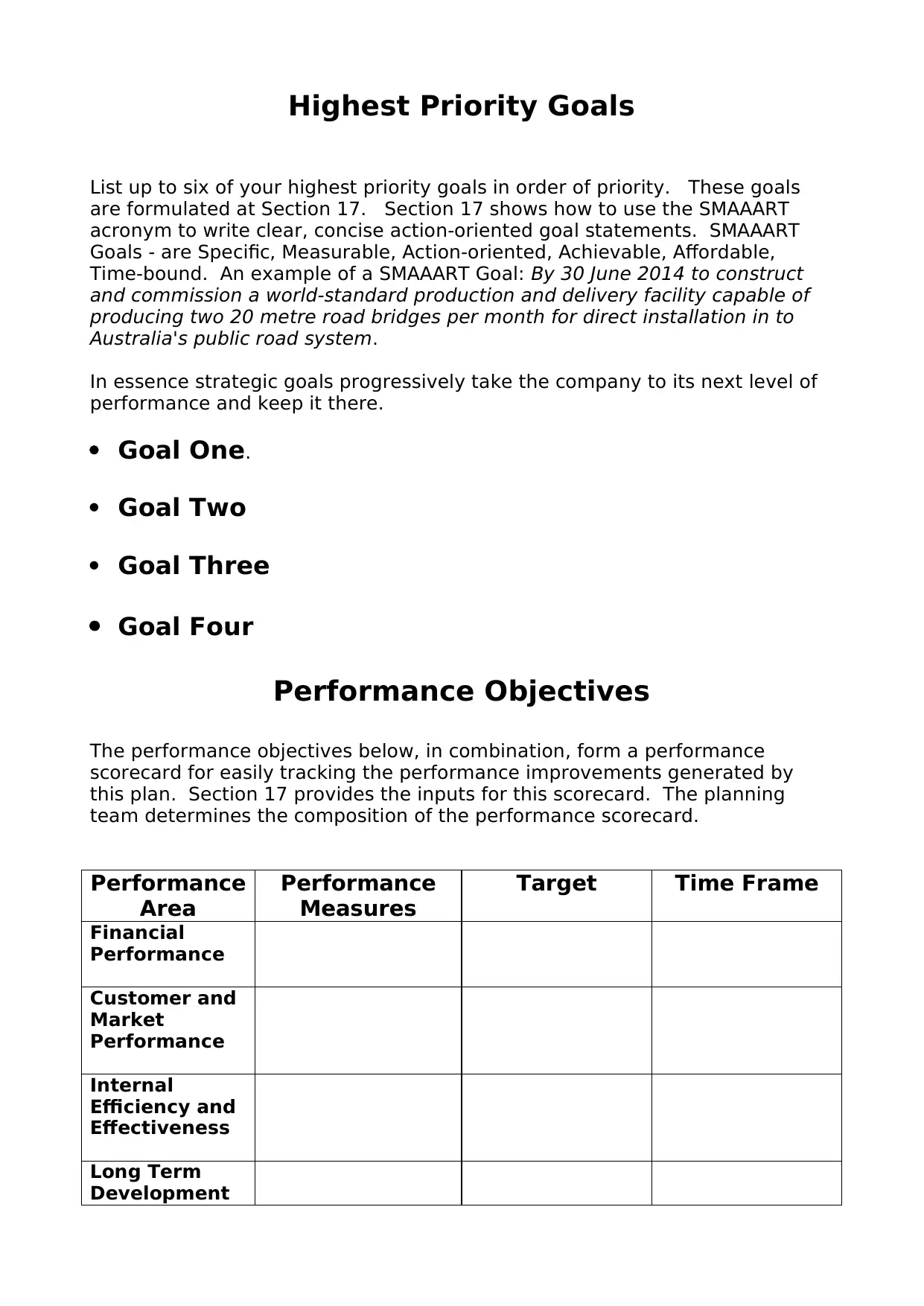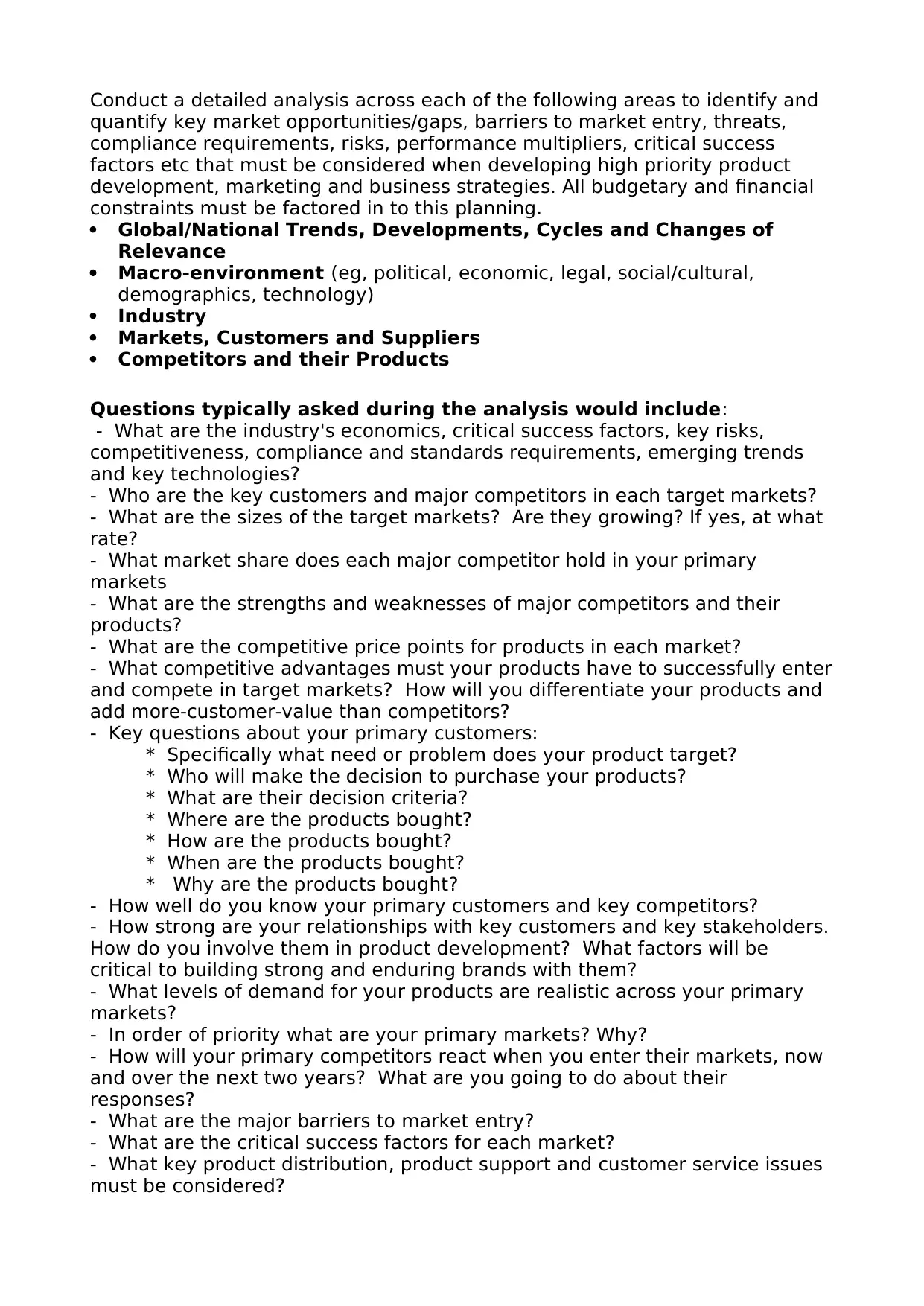Strategic Business Plan Template
VerifiedAdded on 2019/09/19
|28
|4332
|64
Project
AI Summary
This document provides a comprehensive template for creating a strategic business plan. It includes sections such as strategic focus, market analysis, product development, marketing, research and development, production, supply chains, business systems, stakeholder relationships, organizational management, environmental and social impacts, risk management, corporate governance, financials, investment application, strategic action plan, and plan improvement. The template emphasizes the importance of clear goals, objectives, and strategies, and provides guidance on how to develop each section effectively. It also includes tips on writing a concise and action-oriented plan, and highlights the need for regular review and updates.

STRATEGIC BUSINESS PLAN
for
(company name)
for Period
July 2015 to December 2017
(dates are examples only)
Created/Approved by (name), (position), on (date)
Update Status: (amendment number), on (date)
for
(company name)
for Period
July 2015 to December 2017
(dates are examples only)
Created/Approved by (name), (position), on (date)
Update Status: (amendment number), on (date)
Paraphrase This Document
Need a fresh take? Get an instant paraphrase of this document with our AI Paraphraser

TABLE OF CONTENTS
Executive Summary
Section Page
1. Strategic Focus
2. The Business
3 Market Analysis
4 Products
5 Marketing
6 Research and Development
7 Production and Delivery
8 Supply Chains
9 Business Systems and Processes
10 Stakeholder Relationships and Alliances
11 Organisational and Management
12 Environmental and Social Impacts
13 Risk Factors and Regulatory Compliance
14 Corporate Governance
15 Financials
16 Application of Investment Funds
17 Strategic Action Plan
18 Plan Improvement
Appendices:
1.
2.
3.
Executive Summary
Section Page
1. Strategic Focus
2. The Business
3 Market Analysis
4 Products
5 Marketing
6 Research and Development
7 Production and Delivery
8 Supply Chains
9 Business Systems and Processes
10 Stakeholder Relationships and Alliances
11 Organisational and Management
12 Environmental and Social Impacts
13 Risk Factors and Regulatory Compliance
14 Corporate Governance
15 Financials
16 Application of Investment Funds
17 Strategic Action Plan
18 Plan Improvement
Appendices:
1.
2.
3.

Some Thoughts on Writing this Plan
before We Start
Clearly identify the readers of this document. Then write the plan in a style
that is easily understood by readers
Remember that this plan is a working document that has the clear purpose
of initiating focussed action and generating clear and measurable results.
Avoid the excessive use of descriptive adjectives to 'pad' or over-sell the
plan. Flowery, highly descriptive language can cloud key issues, blur the
plan's focus and slow/confuse its implementation
Keep the plan 'tight'; ensure it remains concise, balanced, clear and logical.
Where possible use quantitative rather than qualitative information.
Remember the KISSS approach to planning; keep it simple, short and
specific. Interlink all Sections, with the Market Analysis providing a clear
focus for all subsequent sections.
Focus on facts and information from credible and reputable sources.
Where possible avoid critical dependencies on one source of information.
Build redundancy in to information sources. Validate, validate, validate all
key information used in the plan
Always remember that faulty assumptions and faulty logic are some of the
greatest hazards to business performance and business planning. Also
remember that a good plan implemented today will always beat an
excellent plan implemented some time in the future. So, get the plan
completed and in to action as soon as is practicable. Also, plans must be
adaptive to changing circumstances. If the plan is not performing be
prepared to complete 'major surgery' on it.
Some Thoughts on a Format for Each Section
The following is a simple, but effective planning format that will fit many of
the sections in this plan. The format is not rigid and should be adapted to the
requirements of individual Sections as applicable. The four sub-sections that
comprise the format are as follows:
Current Situation
Clearly and concisely present the current situation with any contributing
history, and any trends, cycles, changes or future developments that are
relevant
Key Issues
Clearly define the most urgent and important issues as they relate to the
current situation for this Section, and the overall purpose of this plan and the
company's Mission. Key issues are usually those strengths, weaknesses,
opportunities, threats, capability gaps and impediments that impact on
business performance
before We Start
Clearly identify the readers of this document. Then write the plan in a style
that is easily understood by readers
Remember that this plan is a working document that has the clear purpose
of initiating focussed action and generating clear and measurable results.
Avoid the excessive use of descriptive adjectives to 'pad' or over-sell the
plan. Flowery, highly descriptive language can cloud key issues, blur the
plan's focus and slow/confuse its implementation
Keep the plan 'tight'; ensure it remains concise, balanced, clear and logical.
Where possible use quantitative rather than qualitative information.
Remember the KISSS approach to planning; keep it simple, short and
specific. Interlink all Sections, with the Market Analysis providing a clear
focus for all subsequent sections.
Focus on facts and information from credible and reputable sources.
Where possible avoid critical dependencies on one source of information.
Build redundancy in to information sources. Validate, validate, validate all
key information used in the plan
Always remember that faulty assumptions and faulty logic are some of the
greatest hazards to business performance and business planning. Also
remember that a good plan implemented today will always beat an
excellent plan implemented some time in the future. So, get the plan
completed and in to action as soon as is practicable. Also, plans must be
adaptive to changing circumstances. If the plan is not performing be
prepared to complete 'major surgery' on it.
Some Thoughts on a Format for Each Section
The following is a simple, but effective planning format that will fit many of
the sections in this plan. The format is not rigid and should be adapted to the
requirements of individual Sections as applicable. The four sub-sections that
comprise the format are as follows:
Current Situation
Clearly and concisely present the current situation with any contributing
history, and any trends, cycles, changes or future developments that are
relevant
Key Issues
Clearly define the most urgent and important issues as they relate to the
current situation for this Section, and the overall purpose of this plan and the
company's Mission. Key issues are usually those strengths, weaknesses,
opportunities, threats, capability gaps and impediments that impact on
business performance
⊘ This is a preview!⊘
Do you want full access?
Subscribe today to unlock all pages.

Trusted by 1+ million students worldwide

Strategies to Address the Key Issues
Formulate strategies using the SMAAART acronym to address the key issues.
SMAAART - Specific, Measurable, Action-orientated, Achievable, Affordable,
Relevant and Time-bound
Key Performance Measures and Targets
Establish key performance measures/indicators, performance targets and time
lines in conjunction with the strategies to assess and improve performance
Five Tests for a Good Strategic Business Plan
Comprehension
Am I satisfied that all readers of this plan will clearly understand it?
Appropriateness
Am I satisfied that the strategic/business directions proposed are
aligned with the company's constitution?
Sustainability
Am I satisfied that the strategic/business directions proposed are of
a nature and quality that should ensure the future?
Feasibility
Am I satisfied that:
* All company implications of the strategic/business directions
proposed have been considered thoroughly,
* Implementation is possible, and
* All supporting goals, objectives and strategies are realistic,
practically achievable, affordable and comprehensive?
Accountability
Am I satisfied that:
Formulate strategies using the SMAAART acronym to address the key issues.
SMAAART - Specific, Measurable, Action-orientated, Achievable, Affordable,
Relevant and Time-bound
Key Performance Measures and Targets
Establish key performance measures/indicators, performance targets and time
lines in conjunction with the strategies to assess and improve performance
Five Tests for a Good Strategic Business Plan
Comprehension
Am I satisfied that all readers of this plan will clearly understand it?
Appropriateness
Am I satisfied that the strategic/business directions proposed are
aligned with the company's constitution?
Sustainability
Am I satisfied that the strategic/business directions proposed are of
a nature and quality that should ensure the future?
Feasibility
Am I satisfied that:
* All company implications of the strategic/business directions
proposed have been considered thoroughly,
* Implementation is possible, and
* All supporting goals, objectives and strategies are realistic,
practically achievable, affordable and comprehensive?
Accountability
Am I satisfied that:
Paraphrase This Document
Need a fresh take? Get an instant paraphrase of this document with our AI Paraphraser

* Management accountability is clearly defined,
* Management is adequately resourced and well prepared to
implement this plan,
* Effective remedial action has been planned in the event a
management shortcoming occurs with plan implementation?
* Management is adequately resourced and well prepared to
implement this plan,
* Effective remedial action has been planned in the event a
management shortcoming occurs with plan implementation?

EXECUTIVE SUMMARY
The Executive Summary is the last section written. It should be restricted to
two to three pages in length. In essence the Executive Summary is a very
effective distillation of the overall business plan into a 'hard hitting' summary
of key performance initiatives and performance targets. Typically it would
include the following:
The Business Opportunity
The Product
The Market Strategy
The Management Team
Profit and Cash Projections
Investment Needs
Returns to Investors
SECTION ONE
STRATEGIC FOCUS
The Executive Summary is the last section written. It should be restricted to
two to three pages in length. In essence the Executive Summary is a very
effective distillation of the overall business plan into a 'hard hitting' summary
of key performance initiatives and performance targets. Typically it would
include the following:
The Business Opportunity
The Product
The Market Strategy
The Management Team
Profit and Cash Projections
Investment Needs
Returns to Investors
SECTION ONE
STRATEGIC FOCUS
⊘ This is a preview!⊘
Do you want full access?
Subscribe today to unlock all pages.

Trusted by 1+ million students worldwide

The Aim of this Plan
What do we wish to achieve with this plan?…start, grow, consolidate,
downsize or exit.
Our Mission
A Mission Statement clearly defines the primary purpose or reasons
for our existence. It is heavily focused on Customer Value. It is also
vital to achieving organisational alignment
A mission statement typically provides clear and concise answers to the
following questions:
What products and services do we deliver?
Where and when do we deliver our products and services?
Which customer groups are our primary groups?
Where are our primary customers
What tangible value do our products and services deliver to customers?
What is our competitive advantage?
What additional community and environmental benefits do we generate?
Answers to the above questions provide a start-point for preparing a
statement that clearly positions the company in the minds of key stakeholders
and customers
Core Organisational Competencies
Which core organisational skills and competencies are vital to achieving our
mission
Organisational Values
What core organisational values must be imbedded in our organisation to
establish a culture capable of achieving our Mission?
What do we wish to achieve with this plan?…start, grow, consolidate,
downsize or exit.
Our Mission
A Mission Statement clearly defines the primary purpose or reasons
for our existence. It is heavily focused on Customer Value. It is also
vital to achieving organisational alignment
A mission statement typically provides clear and concise answers to the
following questions:
What products and services do we deliver?
Where and when do we deliver our products and services?
Which customer groups are our primary groups?
Where are our primary customers
What tangible value do our products and services deliver to customers?
What is our competitive advantage?
What additional community and environmental benefits do we generate?
Answers to the above questions provide a start-point for preparing a
statement that clearly positions the company in the minds of key stakeholders
and customers
Core Organisational Competencies
Which core organisational skills and competencies are vital to achieving our
mission
Organisational Values
What core organisational values must be imbedded in our organisation to
establish a culture capable of achieving our Mission?
Paraphrase This Document
Need a fresh take? Get an instant paraphrase of this document with our AI Paraphraser

Highest Priority Goals
List up to six of your highest priority goals in order of priority. These goals
are formulated at Section 17. Section 17 shows how to use the SMAAART
acronym to write clear, concise action-oriented goal statements. SMAAART
Goals - are Specific, Measurable, Action-oriented, Achievable, Affordable,
Time-bound. An example of a SMAAART Goal: By 30 June 2014 to construct
and commission a world-standard production and delivery facility capable of
producing two 20 metre road bridges per month for direct installation in to
Australia's public road system.
In essence strategic goals progressively take the company to its next level of
performance and keep it there.
Goal One.
Goal Two
Goal Three
Goal Four
Performance Objectives
The performance objectives below, in combination, form a performance
scorecard for easily tracking the performance improvements generated by
this plan. Section 17 provides the inputs for this scorecard. The planning
team determines the composition of the performance scorecard.
Performance
Area
Performance
Measures
Target Time Frame
Financial
Performance
Customer and
Market
Performance
Internal
Efficiency and
Effectiveness
Long Term
Development
List up to six of your highest priority goals in order of priority. These goals
are formulated at Section 17. Section 17 shows how to use the SMAAART
acronym to write clear, concise action-oriented goal statements. SMAAART
Goals - are Specific, Measurable, Action-oriented, Achievable, Affordable,
Time-bound. An example of a SMAAART Goal: By 30 June 2014 to construct
and commission a world-standard production and delivery facility capable of
producing two 20 metre road bridges per month for direct installation in to
Australia's public road system.
In essence strategic goals progressively take the company to its next level of
performance and keep it there.
Goal One.
Goal Two
Goal Three
Goal Four
Performance Objectives
The performance objectives below, in combination, form a performance
scorecard for easily tracking the performance improvements generated by
this plan. Section 17 provides the inputs for this scorecard. The planning
team determines the composition of the performance scorecard.
Performance
Area
Performance
Measures
Target Time Frame
Financial
Performance
Customer and
Market
Performance
Internal
Efficiency and
Effectiveness
Long Term
Development

and
Innovation
Innovation
⊘ This is a preview!⊘
Do you want full access?
Subscribe today to unlock all pages.

Trusted by 1+ million students worldwide

SECTION TWO
THE BUSINESS
Provide a concise overview of the business. Areas for consideration when
preparing this section to include:
Owners/Directors/Shareholders/Shareholdings
A brief history of the business
Corporate and business cultures
Nature of the business and it main activities
Location
Current stage in its life cycle
Past performance and key achievements
Key business advisors - Solicitor, Banker, Accountant, and Consultants
Relationships with key stakeholders
Competitive strengths and weaknesses
SECTION THREE
MARKET ANALYSIS
THE BUSINESS
Provide a concise overview of the business. Areas for consideration when
preparing this section to include:
Owners/Directors/Shareholders/Shareholdings
A brief history of the business
Corporate and business cultures
Nature of the business and it main activities
Location
Current stage in its life cycle
Past performance and key achievements
Key business advisors - Solicitor, Banker, Accountant, and Consultants
Relationships with key stakeholders
Competitive strengths and weaknesses
SECTION THREE
MARKET ANALYSIS
Paraphrase This Document
Need a fresh take? Get an instant paraphrase of this document with our AI Paraphraser

Conduct a detailed analysis across each of the following areas to identify and
quantify key market opportunities/gaps, barriers to market entry, threats,
compliance requirements, risks, performance multipliers, critical success
factors etc that must be considered when developing high priority product
development, marketing and business strategies. All budgetary and financial
constraints must be factored in to this planning.
Global/National Trends, Developments, Cycles and Changes of
Relevance
Macro-environment (eg, political, economic, legal, social/cultural,
demographics, technology)
Industry
Markets, Customers and Suppliers
Competitors and their Products
Questions typically asked during the analysis would include:
- What are the industry's economics, critical success factors, key risks,
competitiveness, compliance and standards requirements, emerging trends
and key technologies?
- Who are the key customers and major competitors in each target markets?
- What are the sizes of the target markets? Are they growing? If yes, at what
rate?
- What market share does each major competitor hold in your primary
markets
- What are the strengths and weaknesses of major competitors and their
products?
- What are the competitive price points for products in each market?
- What competitive advantages must your products have to successfully enter
and compete in target markets? How will you differentiate your products and
add more-customer-value than competitors?
- Key questions about your primary customers:
* Specifically what need or problem does your product target?
* Who will make the decision to purchase your products?
* What are their decision criteria?
* Where are the products bought?
* How are the products bought?
* When are the products bought?
* Why are the products bought?
- How well do you know your primary customers and key competitors?
- How strong are your relationships with key customers and key stakeholders.
How do you involve them in product development? What factors will be
critical to building strong and enduring brands with them?
- What levels of demand for your products are realistic across your primary
markets?
- In order of priority what are your primary markets? Why?
- How will your primary competitors react when you enter their markets, now
and over the next two years? What are you going to do about their
responses?
- What are the major barriers to market entry?
- What are the critical success factors for each market?
- What key product distribution, product support and customer service issues
must be considered?
quantify key market opportunities/gaps, barriers to market entry, threats,
compliance requirements, risks, performance multipliers, critical success
factors etc that must be considered when developing high priority product
development, marketing and business strategies. All budgetary and financial
constraints must be factored in to this planning.
Global/National Trends, Developments, Cycles and Changes of
Relevance
Macro-environment (eg, political, economic, legal, social/cultural,
demographics, technology)
Industry
Markets, Customers and Suppliers
Competitors and their Products
Questions typically asked during the analysis would include:
- What are the industry's economics, critical success factors, key risks,
competitiveness, compliance and standards requirements, emerging trends
and key technologies?
- Who are the key customers and major competitors in each target markets?
- What are the sizes of the target markets? Are they growing? If yes, at what
rate?
- What market share does each major competitor hold in your primary
markets
- What are the strengths and weaknesses of major competitors and their
products?
- What are the competitive price points for products in each market?
- What competitive advantages must your products have to successfully enter
and compete in target markets? How will you differentiate your products and
add more-customer-value than competitors?
- Key questions about your primary customers:
* Specifically what need or problem does your product target?
* Who will make the decision to purchase your products?
* What are their decision criteria?
* Where are the products bought?
* How are the products bought?
* When are the products bought?
* Why are the products bought?
- How well do you know your primary customers and key competitors?
- How strong are your relationships with key customers and key stakeholders.
How do you involve them in product development? What factors will be
critical to building strong and enduring brands with them?
- What levels of demand for your products are realistic across your primary
markets?
- In order of priority what are your primary markets? Why?
- How will your primary competitors react when you enter their markets, now
and over the next two years? What are you going to do about their
responses?
- What are the major barriers to market entry?
- What are the critical success factors for each market?
- What key product distribution, product support and customer service issues
must be considered?

- Which companies and products are likely to become competitors in the
future?
- What new or emerging technologies and substitute products are likely to
become threats in the future?
future?
- What new or emerging technologies and substitute products are likely to
become threats in the future?
⊘ This is a preview!⊘
Do you want full access?
Subscribe today to unlock all pages.

Trusted by 1+ million students worldwide
1 out of 28
Related Documents
Your All-in-One AI-Powered Toolkit for Academic Success.
+13062052269
info@desklib.com
Available 24*7 on WhatsApp / Email
![[object Object]](/_next/static/media/star-bottom.7253800d.svg)
Unlock your academic potential
Copyright © 2020–2025 A2Z Services. All Rights Reserved. Developed and managed by ZUCOL.




